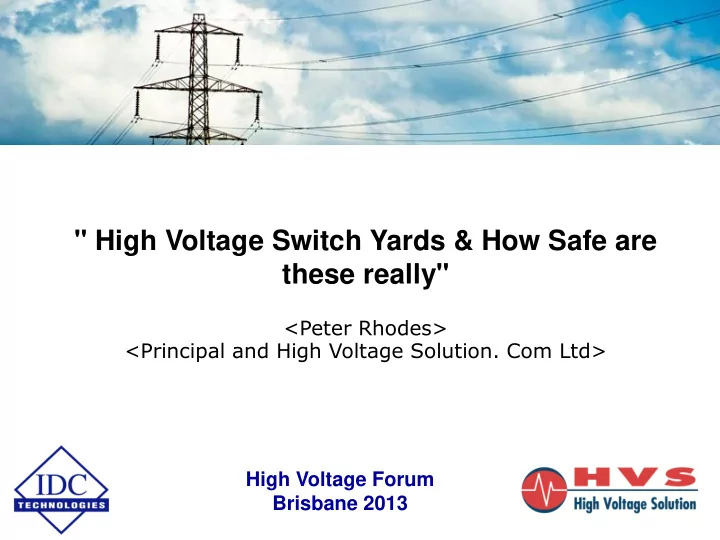

" High Voltage Switch Yards & How Safe are these really" <Peter Rhodes> <Principal and High Voltage Solution. Com Ltd> High Voltage Forum Brisbane 2013
Duty of Care • As part of an asset owner “Duty of care to their workers & contractors” Asset owners and or operations groups are required to ensure the place of work is safe . • Instrument transformers & current transformers are critical components of the substations and are used to measure voltage and current for metering / indication & protection. • As these assets age, the risk of failure increases – lightening prone areas often weaken the internal insulation, external contamination (ozone, water) are the main factors causing degradation on the surface of this equipment. • Partial discharge can develop either internally or superficially. In- service / on line testing is used to detect partial discharge on line before they reach critical levels without taking the equipment out of service or manipulating its operating conditions.
When an unplanned outage occurs, production stops, and in most cases, will cause waste and damage to occur within the plant. By using On-Line Partial Discharge (PD) Testing it is possible to have a “Real Time” report on the condition of circuit breaker porcelain bushings while plant is still running and in service, with no production outages required. This is ideal for the any 24/7 operation such as mining, refineries and export operations / hydro electric power stations etc.
Failure 1 33kV Current Transformer Failure
The weakest links in a switchyard installation can often be Circuit breakers / voltage transformers / current transformers and surge arrestors in older pre 1970 switchyards. The failure mechanism in most cases is the ingress of moisture and free water contaminating the oil surrounding the paper taped stress control bushing
Failure 2 132kV CB Failure
132kV CB Failure
Extremely dangerous and potentially fatal The bushing will initially produce PD and as this level increases over time will develop into an internal arc. This is accompanied by a rapid rise in pressure followed by a “burn through” period, as indicated in the image above.
Pressure release mechanism In the absence of a suitable pressure release mechanism, arcing faults are extremely dangerous and potentially fatal as temperatures can reach 6000°C. The high arc temperature causes a rapid rise in pressure within the bushing causing the bushing to rupture. The diagram below shows a typical example of the release of arc flash energy where inadequate pressure release mechanisms are in place .
Internal Pressure Rise
Burn Through
Failure 3 132kV Voltage Transformer Failure
Failure 4 11kV Synchronising breaker Failure
Failure 5
Being recorded in real time Identifying the location of suspect bushings does require extensive experience to know where to place the various numbers of sensors, (it is not possible to use one sensor) and to analyse this data from the various sensors as it is being recorded in real time.
In Service Testing With the aid of the latest technology, it is now possible to detect potential failures in CB Bushings in-service / on-line, thereby preventing catastrophic arcing failure of the bushings. Apart from the unplanned loss of supply and fire caused when a failure occurs, it has the potential to inflict serious harm to site personnel if they are in the vicinity of a porcelain bushing explosion.
Unlike conventional PD monitors The HVS equipment acquires and stores the actual pulse shape of each signal measured. This enables both frequency and time-domain analysis. The data acquired allows for identification of internal discharges, surface discharges and corona discharges. The bushings per circuit breaker (Load side of CB and Line side of CB) were ranked into three risk different categories: Low / Medium / High. Specific recommendations and order of priority were then given to the client to enable correct order of replacement parts to minimize risk within the switchyard and for possible replacement programs that fitted into production shutdowns.
In-Service Detecting 132kV Voltage Transformer
Case study: Work performed An on-line PD survey of the client’s 1970 switchyard was carried out by High Voltage Solution (HVS) using in- house developed sensors, coupled with an instrument having three input channels that allow for sequential acquisition of PD signals.
Using RFI Equipment
Being able to record and analyse • Finding sources of PD early reduces repair costs and helps keep HV apparatus operating efficiently and maximize unit lifespan. Being able to record and analyse the PD signals and make decisions for further actions is a big plus.
summary of test results From the on-line PD tests HVS was able to measure PD in progress on selected CB bushings. This gave the asset owner the luxury of having a controlled shutdown which controlled the risk to both personnel & adjacent assets within the switchyard.
Instrument's used to detect potential failures • Acoustic detector • Infra-red camera • Corona Camera • RFI Freq
Questions
Recommend
More recommend